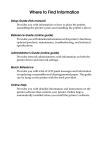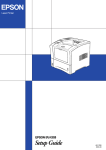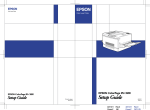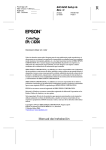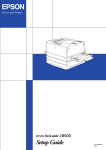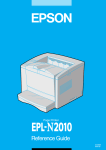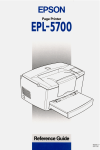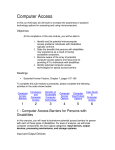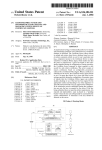Download Epson EPL-N2700 Specifications
Transcript
[Read This First] Page Printer Getting Ready! 4010651 XXX-00 Printer Parts control panel face-down tray power switch MP tray lower cassette cover B ethernet interface serial interface connector connector optional interface slot cover lock lever parallel interface connector cover A AC inlet cover C1 duplex unit connector 5-bin multi-purpose unit connector 10-bin multi-purpose unit connector 2 Contents Printer Parts. . . . . . . . . . . . . . . . . . . . . . . . . . . . . . . . . . . . . . . . . 1 1 ENERGY STAR Compliance . . . . . . . . . . . . . . . . . . . . . . . . . . . . 1 2 Safety Information . . . . . . . . . . . . . . . . . . . . . . . . . . . . . . . . . . . . . 2 Ozone safety . . . . . . . . . . . . . . . . . . . . . . . . . . . . . . . . . . . . . . . . 4 Laser printer precautions . . . . . . . . . . . . . . . . . . . . . . . . . . . . . 5 Important safety instructions . . . . . . . . . . . . . . . . . . . . . . . . . . 7 For United Kingdom users . . . . . . . . . . . . . . . . . . . . . . . . . . . . 9 Warnings, Cautions, and Notes . . . . . . . . . . . . . . . . . . . . . . . . 10 3 Attaching the Quick Reference Box. . . . . . . . . . . . . . . . . . . . . . . 11 4 Attaching the Side Cover . . . . . . . . . . . . . . . . . . . . . . . . . . . . . . . 12 5 Installing the Large Capacity Paper Unit . . . . . . . . . . . . . . . . . . 13 6 Installing the 500-sheet Lower Cassette Unit. . . . . . . . . . . . . . . 18 7 Installing the Imaging Cartridge . . . . . . . . . . . . . . . . . . . . . . . . . 23 8 Attaching the Power Cord . . . . . . . . . . . . . . . . . . . . . . . . . . . . . . 27 9 Loading Paper. . . . . . . . . . . . . . . . . . . . . . . . . . . . . . . . . . . . . . . . . 28 Loading paper in the MP Tray . . . . . . . . . . . . . . . . . . . . . . . . . 28 Loading paper in the Lower Cassette . . . . . . . . . . . . . . . . . . . 32 Selecting the paper size . . . . . . . . . . . . . . . . . . . . . . . . . . . . . . . 36 10 Test Printing . . . . . . . . . . . . . . . . . . . . . . . . . . . . . . . . . . . . . . . . . . 37 11 Connecting the Printer to a Computer . . . . . . . . . . . . . . . . . . . . 38 12 Installing Microsoft® Internet Explorer 4.0 . . . . . . . . . . . . . . . . 40 13 System Requirements . . . . . . . . . . . . . . . . . . . . . . . . . . . . . . . . . . 42 14 For DOS programs . . . . . . . . . . . . . . . . . . . . . . . . . . . . . . . . . . . . . 44 Getting Ready! Where to Find Information Getting Ready! This is a manual which explains setting up the printer and installing the optional Large Capacity Paper Unit and optional 500-sheet Lower Cassette Unit. It explains the preparations which are necessary before the printer can be used, before the installation of the optional Large Capacity Paper Unit and optional 500-sheet Lower Cassette Unit, and before the installation of the Internet Explorer browser software used to view the online manual. Administrator's Guide This is an online manual which explains information needed by the Administrator, including network settings and installation of printer software. You will find this manual in the CD-ROM entitled "Online Guide for the EPL-N2700". For information about how to access and read online manuals, refer to the booklet accompanying the CD-ROM. Use the Internet Explorer browser to view the online manual. Reference Guide This is an online manual which provides detailed information necessary for using the printer, including explanations on the installation of the various options and the different printer functions. You will find this manual in the CD-ROM entitled "Online Guide for the EPL-N2700". For information about how to access and read online manuals, refer to the booklet accompanying the CD-ROM. Use the Internet Explorer browser to view the online manual. Quick Reference Guide This explains the printer messages, how to clear paper jams and how to replace imaging cartridges. Place it in the small box on the front of the printer for safekeeping and easy access. Online Help (Microsoft® Windows® 3.1x, 95, 98, and NT® only) Provides you with detailed information and instructions on the Windowsbased printer software that controls your printer. (Online help is automatically installed when you install the printer software.) See the online Reference Guide for information on accessing online help. EPSON is a registered trademark of SEIKO EPSON CORPORATION. General Notice: Other product names used herein are for identification purposes only and may be trademarks of their respective owners. EPSON disclaims any and all rights in those marks. Copyright © 1999 by SEIKO EPSON CORPORATION, Nagano, Japan iv 1 ENERGY STAR Compliance As an ENERGY STAR Partner, EPSON has determined that this product meets the ENERGY STAR guidelines for energy efficiency. The International ENERGY STAR Office Equipment Program is a voluntary partnership with the computer and office equipment industry to promote the introduction of energy-efficient personal computers, monitors, printers, fax machines, copiers, and scanners, in an effort to reduce air pollution caused by power generation. 1 2 Safety Information Laser safety This printer is certified as a Class 1 laser product under the U.S. Department of Health and Human Services (DHHS) Radiation Performance Standard according to the Radiation Control for Health and Safety Act of 1968. This means that the printer does not produce hazardous laser radiation. Since radiation emitted by the laser is completely confined within protective housings and external covers, the laser beam cannot escape from the machine during any phase of user operation. For European users United Kingdom The EPL-N2700 is a page printer which utilizes a semiconductor laser. There is no possibility of danger from the laser, provided the printer is operated according to the instructions in the guides provided. Since radiation emitted by the laser is completely confined within protective housings, the laser beam cannot escape from the machine during any phase of user operation. w Warning: Use of controls or adjustments, or performance of procedures other than those specified in this guide may result in hazardous radiation exposure. This is a semiconductor laser. The maximum power of the laser diode is 5 mW and the wavelength is 775 to 795 nm. 2 CDRH regulations The Center for Devices and Radiological Health (CDRH) of the U.S. Food and Drug Administration implemented regulations for laser products on August 2, 1976. Compliance is mandatory for products marketed in the United States. The label shown below indicates compliance with the CDRH regulations and must be attached to laser products marketed in the United States. Laser safety labels w Warning: Use of controls, adjustments, or performance of procedures other than those specified in this guide may result in hazardous radiation exposure. Your printer is a Class 1 laser product as defined in IEC 825 specifications. The label shown below is attached in countries where required. 3 Ozone safety Ozone emission Ozone gas is generated by laser printers as a by-product of the printing process. Ozone is produced only when the printer is printing. Ozone exposure limit The recommended exposure limit for ozone is 0.02 parts per million (ppm) expressed as an average time-weighted concentration over an eight-hour period. The EPL-N2700 laser printer generates less than 0.01 ppm for eight hours of continuous printing in a closed room of approximately 1000 cubic feet (8' × 10' × 12'). Minimize exposure risk To minimize the risk of exposure to ozone: ❏ Do not use more than one laser printer in a confined area. ❏ Do not use your printer in conditions of extremely low humidity. ❏ Do not use your printer in a room with poor ventilation. ❏ Avoid long, continuous printing in any of the conditions mentioned above. Printer location The printer should be located so that the exhaust gases and generated heat are: ❏ Not blown directly into the user's face. ❏ Vented directly out of the building whenever possible. 4 Laser printer precautions This printer uses laser technology. The following list of precautions applies whenever you open the printer cover. Even if you are familiar with other types of printers, be sure to follow these precautions carefully to ensure safe, efficient operation. ❏ Do not touch the areas specified on the caution labels inside cover A and cover B. If the printer has been in use, the fuser can be very hot. CAUTION Hot Surface Avoid Contact CAUTION Hot Surface Avoid Contact ❏ Avoid touching the components inside the printer unless instructed to do so in this guide. 5 ❏ Never force the printer's components into place. Although the printer is designed to be sturdy, rough handling can damage it. ❏ Be sure not to scratch the surface of the drum. When you remove the imaging cartridge from the printer, always set the unit on a clean, smooth surface. Also, avoid touching the drum, since oils from your skin can permanently damage its surface and may affect print quality. ❏ Do not turn the cartridge upside down or stand it on its sides. ❏ Protect the light-sensitive drum from exposure to light. Avoid exposing the imaging cartridge to room light any longer than necessary. Do not open the drum's protective cover. Overexposing the drum may cause abnormally dark or light areas to appear on the printed page and reduce the service life of the drum. protective cover ❏ When handling the cartridge, always set it on a clean, smooth surface. ❏ Do not attempt to modify or take apart the cartridge. It cannot be refilled. ❏ Do not touch the toner and avoid all contact with your eyes. 6 ❏ Wait for at least one hour before using a cartridge after moving it from a cool to a warm environment. w Warning: Do not dispose of used imaging cartridges in fire, as they can explode and cause injury. Dispose of them according to local regulations. To get the best print quality, do not store the imaging cartridge in an area subject to direct sunlight, dust, salty air, or corrosive gasses (such as ammonia). Avoid locations subject to high temperatures, humidity, or abrupt changes in temperature or humidity. Also, be sure to keep the consumable components out of the reach of children. Hinweis: ❏ Die Geräteanschlußleitung muß den einshlägigen Normen genügen. Es muß eine dreiadrige Leitung verwendet werden. Die Anshlußleitung darf nicht leichter als H05VV-F order H05VVH2F sein. ❏ Maschinenlärminformations-Verordnung-3. GSGV, 18. 01. 1991: Der arbeitsplatzbezogene schalldruckpegel beträgt 70 dB (A) oder weniger gemäß ISO 7779. Important safety instructions Read all of these instructions before operating your printer. ❏ Follow all warnings and instructions marked on the printer. ❏ Unplug the printer from the wall outlet before cleaning. ❏ Use a damp cloth for cleaning and do not use liquid or aerosol cleaners. ❏ Do not use this printer near water. ❏ Do not place the printer on an unstable cart, stand, or table. 7 ❏ Slots and openings in the cabinet and at the back and bottom of the printer are provided for ventilation. Do not block or cover them and do not put the printer on beds, sofas, rugs, or other soft surfaces that may block ventilation. Do not place the printer in an enclosure unless proper ventilation is provided. ❏ Use the type of power source indicated on the label. If you are not sure of the type of power available, consult your dealer or local power company. ❏ If you are unable to insert the plug into the outlet, contact your electrician to have your outlet repaired or replaced. ❏ Do not put your printer where the cord might be stepped on. ❏ Avoid using outlets that other appliances are plugged into. ❏ Only use an outlet that meets the power requirements for this printer. ❏ Never push objects of any kind through cabinet slots as they may touch dangerous voltage points or short out parts which could result in fire or electric shock. Never spill liquid of any kind on the printer. ❏ Except as specifically explained in this guide, do not attempt to service this product yourself. Opening or removing covers that are marked “Do Not Remove” exposes you to dangerous voltage. Refer all servicing in those compartments to service personnel. ❏ Unplug the printer from the wall outlet and refer servicing to qualified service personnel under the following conditions: A) If liquid has been spilled into it. B) If it has been exposed to rain or water. 8 C) If it does not operate normally when the operating instructions are followed. Adjust only those controls that are covered by the operating instructions since improper adjustment of other controls may result in damage and will often require extensive work by a qualified technician to restore the product to normal operation. D) If it has been dropped or the cabinet has been damaged. E) If it exhibits a distinct change in performance and a message indicating a need for service appears on the LCD panel. F) When the power cord or plug is damaged or frayed. For United Kingdom users Use of options EPSON (UK) Limited shall not be liable against any damages or problems arising from the use of any options or consumable products other than those designated as Original EPSON Products or EPSON Approved Products by EPSON (UK) Limited. Safety information w Warning: This appliance must be earthed. Refer to rating plate for voltage and check that the appliance voltage corresponds to the supply voltage. Important: The wires in the mains lead fitted to this appliance are coloured in accordance with the following code: Green and yellow—Earth Blue—Neutral Brown—Live 9 If you need to fit a plug: As the colours of the mains lead of this appliance may not match any coloured markings used to identify the terminals in a plug, please proceed as follows: ❏ The green and yellow wire must be connected to the terminal in the plug which is marked with the letter E or the Earth symbol (G). ❏ The blue wire must be connected to the terminal in the plug marked with the letter N. ❏ The brown wire must be connected to the terminal in the plug marked with the letter L. If damage occurs to the plug, replace the cord set or consult a qualified electrician. Replace fuses only with a fuse of the correct size and rating. Warnings, Cautions, and Notes w c Warnings must be followed carefully to avoid bodily injury. Cautions must be observed to avoid damage to your equipment. Notes contain important information and useful tips on the operation of your printer. 10 3 Attaching the Quick Reference Box Use the quick reference box for storing the Quick Reference Guide if the guide is included with your printer. Insert the knob on the bottom of the quick reference box into the slot on the left of the printer. Then attach the quick reference box by inserting the knobs into the slots on each side. If you installed the 10-Bin Multi-Purpose Unit, attach the quick reference box to the back of the printer as shown below. 11 4 Attaching the Side Cover Attach the printer's side cover unless the optional Large Capacity Paper Unit is installed. Note: If the optional 500-sheet Lower Cassette Unit is installed, attach the side cover to the lowermost 500-sheet Lower Cassette Unit. 1. Remove the side cover from the box and confirm the direction in which it is to be attached. 2. Fit the side cover to the bottom of the printer. After fitting the side cover into the slot to the rear of the printer, fit the other end in the slot to the front. 12 5 Installing the Large Capacity Paper Unit It is best to install the Large Capacity Paper Unit when first setting up the printer. Please note that you will need the assistance of at least two other people to lift up the printer when installing this option. Follow these instructions to install the Large Capacity Paper Unit. 1. Open the shipping carton. 2. Remove the inserts and all other protective materials inside the box. Make sure the contents of the package match the items on the included documentation. Remove the packaging materials and any other items from the unit and store them for future use. 3. With the assistance of two or more people, lift the Large Capacity Paper Unit out of the box and place it near the printer. 13 4. You will find three casters at the bottom of the Large Capacity Paper Unit. Lock the casters by pushing their levers down. 5. If you are also installing a 500-Sheet Lower Cassette Unit, stack it on top of the Large Capacity Paper Unit. For instructions on how to prepare the Lower Cassette Unit for installation, see “Installing the 500-sheet Lower Cassette Unit” on page 18. 6. Remove the side cover from the bottom of the printer. 14 7. With the assistance of two or more people, grasp the printer at the positions indicated below and lift it carefully. Front c Rear Caution: The printer weighs about 30 kg (66.1 lb); always lift it with two or more people. 8. Align each of the printer’s corners with those of the unit, then lower the printer until it rests securely on the unit. 15 9. Make sure all corners of the printer fit firmly onto the unit. Then pull out the cassette and fasten the unit using the fittings and screws provided. 10. On the back of the printer, fasten the unit using the fittings and screws provided. 16 11. Pull the cassette out of the unit and remove the protective materials. 12. Peel the appropriate cover and cassette numbering labels from the label sheet included with the Large Capacity Paper Unit and attach it to the unit. 13. Pull out the cassette and attach the printer supports and printer support covers to the front of the printer as shown below. Then attach the printer supports to the back of the printer. 17 6 Installing the 500-sheet Lower Cassette Unit It is best to install the Lower Cassette Unit when first setting up the printer. You can install up to two Lower Cassettes, or one Lower Cassette plus the optional Large Capacity Paper Unit. Please note that you will need the assistance of at least two other people to lift up the printer when installing this option. Follow these instructions to install the Lower Cassette Unit. 1. Open the shipping carton. 2. Remove the inserts and all other protective materials inside the box. Make sure the contents of the package match the items on the included documentation. Remove the packaging materials and any other items from the Lower Cassette Unit and store them for future use. 3. Lift the Lower Cassette out of the box and place it near the printer. If you plan to use more than one Lower Cassette, stack the cassettes with the front of each cassette facing the same direction. 18 If you plan to install the Large Capacity Paper Unit at the same time, follow the instructions in “Installing the Large Capacity Paper Unit” on page 13 to complete the installation of both units. 4. Remove the side cover from the bottom of the printer. 5. With the assistance of two or more people, grasp the printer at the positions indicated below and lift it carefully. Front c Rear Caution: The printer weighs about 30 kg (66.1 lb); always lift it with two or more people. 19 6. Align each of the printer’s corners with those of the cassette unit, then lower the printer until it rests securely on the unit. 7. Make sure all corners of the printer fit firmly onto the unit. 8. Pull out the cassette and fasten the Lower Cassette Unit using the fittings and screws provided. 20 9. On the back of the printer, fasten the unit using the fittings and screws provided. 10. Pull the cassette out and remove the protective materials. 11. Attach the side cover to the bottom of the cassette unit as shown below. 21 12. Peel the appropriate cover and cassette numbering labels from the label sheet included with cassette unit, and attach them to the unit as shown below. 22 7 Installing the Imaging Cartridge 1. While holding the imaging cartridge horizontally, gently rock it back and forth a few times to distribute the toner evenly. c Caution: ❏ Do not turn the imaging cartridge upside down. ❏ Do not open the drum's protective cover and avoid exposing the imaging cartridge to room light any longer than necessary. Overexposing the cartridge may cause abnormally dark or light areas to appear on the printed page and reduce the life of the cartridge. protective cover 23 2. While holding down the carrying handle so that it doesn't fly out, peel off the tape that is affixed to the handle. Release the handle by removing your hand from it gently and the handle will automatically eject. c Caution: When you peel the tape off, the handle will quickly eject so that it could injure your fingers. To avoid this, hold the handle in position firmly while peeling off the tape. 3. Open cover A gently by pulling the latch. 24 w Warning Do not touch the hot areas indicated on the caution labels inside cover A. CAUTION Hot Surface Avoid Contact 4. Holding the Left and Right handles on the imaging cartridge, insert it into the printer until it is firmly seated. 25 5. Close cover A by pushing it up and into the printer. c 26 Caution: Never transport the printer with the imaging cartridge installed. 8 Attaching the Power Cord 1. Make sure the power switch on the front of the printer is turned off. 2. Insert the power cord into the AC inlet at the back of the printer, then plug the other end into a properly grounded outlet. c Caution: ❏ Avoid using outlets that other appliances are plugged into. ❏ Only use an outlet that meets the power requirements for this printer. 27 9 Loading Paper This section includes instructions for loading paper in the MP Tray and the Lower Cassette. Note: The printer also supports an optional 500-sheet Lower Cassette Unit, which uses the same loading method as the standard Lower Cassette. Loading paper in the MP Tray The MP Tray can accommodate various types and sizes of paper and envelopes. It handles 250 sheets, allowing you to load a total of 750 sheets when used in combination with the Lower Cassette. You can load the following paper sizes. The loading orientation differs depending on the paper size, as explained below: Loading Orientation Paper Size Vertical A4, A5, Executive, Letter, B5, G-Letter, HTL Horizontal A3, Ledger, Legal, B4, F4, G-Legal To confirm paper sizes, see “Paper Specifications” in Appendix A of the Reference Guide. Note: When you load Excutive, G-Letter, HTL, Ledger, B4, G-Legal, and other custom paper sizes, select the paper size in the printer driver, then set the paper size for MP Tray using the SelecType Tray menu. For instructions, see "SelecType settings" in the Reference Guide. 28 To load paper in the MP Tray, follow the steps below. 1. Pull out the paper cassette, and remove the protective materials inside. 2. Push down the inner tray until it clicks on the bottom of the cassette. 29 3. While pulling up the vertical and horizontal paper guide, slide it to match the size of your paper. 4. Fan a stack of paper and tap it on a flat surface to even the edges. Insert the paper face up into the cassette, aligning the corners of the paper with the arrow mark inside the cassette. Printable side up Note: ❏ Be sure not to load paper higher than the arrow mark. ❏ If your printouts are curled or do not stack properly when using plain paper, try turning the stack over and reloading it. 30 5. Adjust the vertical and horizontal paper guides to match the size of your paper. c Caution: Make sure to adjust the paper guides to the paper size you load; otherwise, the printer will not print properly. 6. Close the paper cassette. 31 7. Peel the appropriate paper size label from the label sheet included with your printer and attach it to the cassette. Loading paper in the Lower Cassette The Lower Cassette can accommodate a variety of paper sizes. It handles 500 sheets, allowing you to load a total of 750 sheets when used in combination with the MP Tray. You can load the following paper sizes. The loading orientation differs depending on the paper size, as explained below: Loading Orientation Paper Size Vertical A4, Letter, Government Letter Horizontal A3, Ledger, Legal, B4 To confirm paper sizes, see “Paper Specifications” in Appendix A of the Reference Guide. 32 To load paper in the Lower Cassette, or in an optional 500-sheet Lower Cassette Unit, follow the steps below. 1. Pull out the cassette all the way out, and remove the protective materials inside. 2. Push down the inner tray until it clicks on the bottom of the cassette. 33 3. While pulling up the vertical paper guide, slide it to match the paper size. 4. Insert the horizontal paper guide into the slot for the paper size you want to load. 34 5. Fan a stack of paper and tap it on a flat surface to even the edges. Insert the paper face up into the cassette, aligning the corners of the paper with the arrow mark inside the cassette. Printable side up Note: ❏ Be sure not to load paper higher than the arrow mark. ❏ If your printouts are curled or do not stack properly when using plain paper, try turning the stack over and reloading it. c Caution: Make sure to adjust the paper guides to the paper size you load; otherwise, the printer will not print properly. 6. Set the paper size with the paper-size dial. 35 7. Close the paper cassette. 8. Peel the appropriate paper size label from the label sheet included with your printer and attach it to the cassette. Selecting the paper size By default, the printer driver is set for A4 size paper. If you load paper of a different size, change the paper size setting on the printer driver’s Basic Settings menu. For more information on using the printer driver, see the driver’s online help. You can also change this setting from the printer’s control panel using OneTouch mode 1. For details, see “Using the OneTouch Modes” in the Reference Guide. 36 10 Test Printing 1. Make sure the imaging cartridge is installed. Turn on the printer. Several messages will appear on the display as the printer performs internal tests. After about 10 seconds, the Ready message will appear. 2. Make sure the On Line light is on. This indicates that the printer is ready to accept and print data. If it isn't on, press the On Line button. 3. Press Enter two times. The printer will print the status sheet, showing the current printer settings. When printing is completed, the On Line light will blink. Enter button 37 11 Connecting the Printer to a Computer Though this printer is intended to be used on a network, you can use the parallel interface to connect the printer directly to a computer. Note: Your printer also has room for an optional interface. See Chapter 4, “Handling Options,” in your Reference Guide for more information. To connect the parallel interface, follow the steps below. 1. Make sure both the printer and the computer are off. 2. Connect the parallel cable to the parallel interface connector. Note: Use only a shielded, twisted-pair parallel cable. parallel interface connector 38 3. Secure the connector by pushing the two wire clips together until they lock in place on both sides of the connector. 4. Connect the other end of the cable to your computer, and fasten it as required. 5. Turn on the printer, then turn on your computer. 39 12 Installing Microsoft® Internet Explorer 4.0 A Web browser is required to use these guides. If you do not have a Web browser, install Microsoft Internet Explorer 4.0 from the online guide CD. For Windows Note for Windows 98 users: Windows 98 comes with Internet Explorer 4.0 already installed; please skip this section. Note for Windows NT 4.0 users: Before installing Microsoft Internet Explorer 4.0, you need to install the Windows NT Service Pack 3. For installation instructions, see the read me file located in the online guide CD at Browser\Win95nt\NT4sp3\Readme.txt. Read also License.txt in the same directory. 1. Insert the online guide CD in your CD-ROM drive. If a dialog box appears with options to view or install the guides, click Quit. 2. Double-click the My Computer icon, then double-click the CD-ROM icon. For Windows 3.1, click the CD-ROM drive in File Manager. 3. Double-click the Browser folder. 4. For Windows 95 or NT 4.0: double-click Win95nt then double-click Ie40. For Windows 3.1: double-click Win31. 5. Double-click ie4setup.exe (for Windows 95 or NT 4.0) or Setup.exe (for Windows 3.1) and follow the on-screen instructions. 40 For Macintosh 1. Insert the online guide CD in your CD-ROM drive. 2. Double-click the Browser folder. 3. Double-click ppc or 68k depending on your Macintosh CPU. 4. Double-click ie4setup and follow the instructions on the screen. 41 13 System Requirements For Windows System: Microsoft Windows® 3.1, 95, 98, or NT 4.0 CPU: i486/25 MHz (for Windows 95/ NT 4.0) i486/66 MHz (for Windows 98) i386/25 MHz (for Windows 3.1) (Pentium or higher recommended) Memory: 16 MB (32 MB or more recommended) Hard disk space: 4 MB to install the Reference Guide 15 MB to install Microsoft Internet Explorer 4.0 CD-ROM drive: Double-speed (Quad-speed or faster recommended) 42 Display: 640 x 480 pixel or 800 x 600 pixel resolution, with High Color (16 bit) or True Color (32 bit) setting Browser: Web browser (Microsoft Internet Explorer 4.0 or later recommended) For Macintosh System: System 7.5.1 (System 7.6 or later recommended) Memory: 16 MB (32 MB or more recommended) Hard disk space: 4 MB to install the Reference Guide 15 MB to install Microsoft Internet Explorer CD-ROM drive: Double-speed (Quad-speed or faster recommended) Display: Color monitor with 640 x 480 pixel resolution or greater (Thousands of colors recommended) Browser: Web browser (Microsoft Internet Explorer 4.0 or later recommended) 43 14 For DOS programs Since DOS application programs differ in their driver selection procedures, there is no standard way to select the printer driver. See your software manual for information on how to select the printer. When asked to select a printer, pick the first printer available in the list below. EPL-N4000 EPL-5500/5500+ EPL-N1200 EPL-N2000 EPL-5600 EPL-3000 EPL-5200/5200+ HP LaserJet III/IIIP/IIID HP LaserJet III Si HP LaserJer 4L EPL-9000 HP LaserJer 4 HP LaserJer 4V If you choose a printer other than the EPL-N2700, you may not be able to use some printer features. 44 Page Printer Getting Ready! Printed in Japan 99.XX-XX


















































